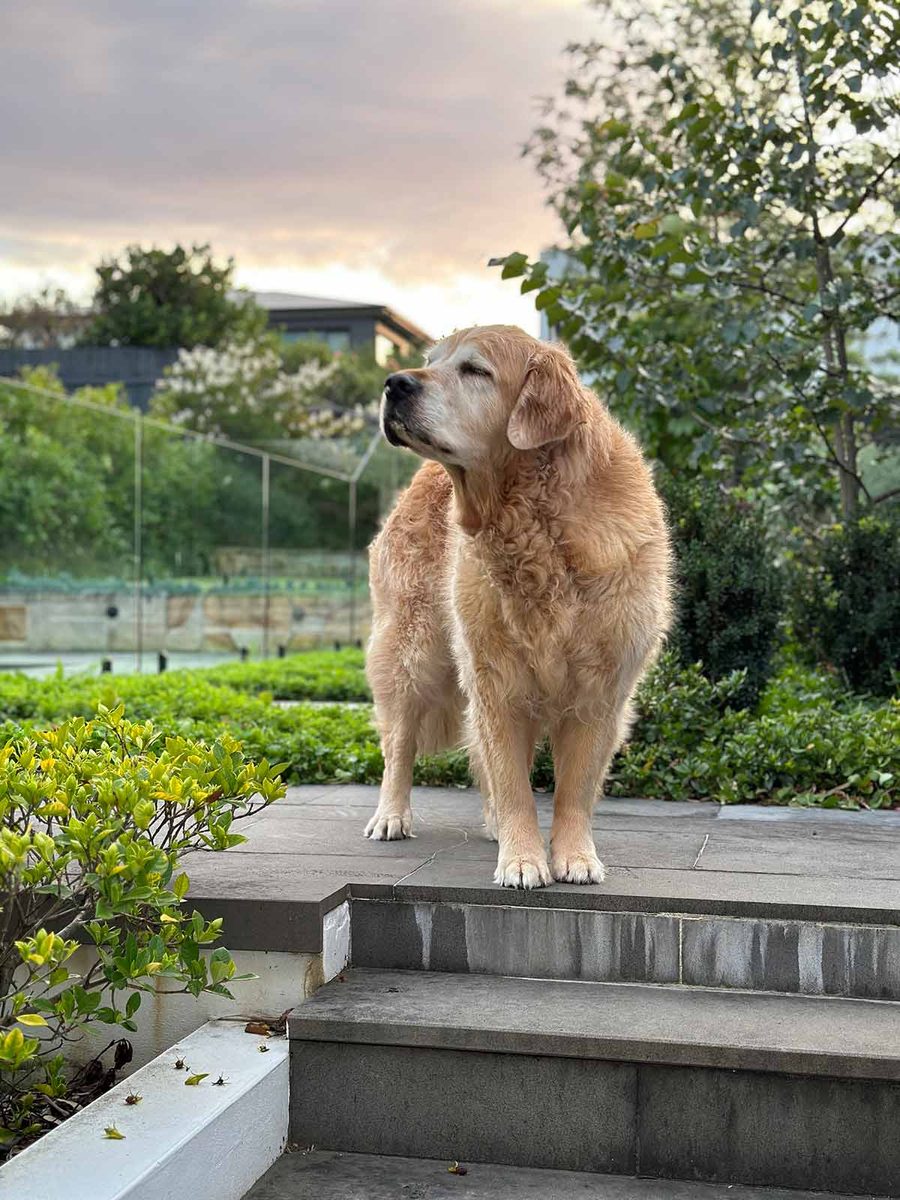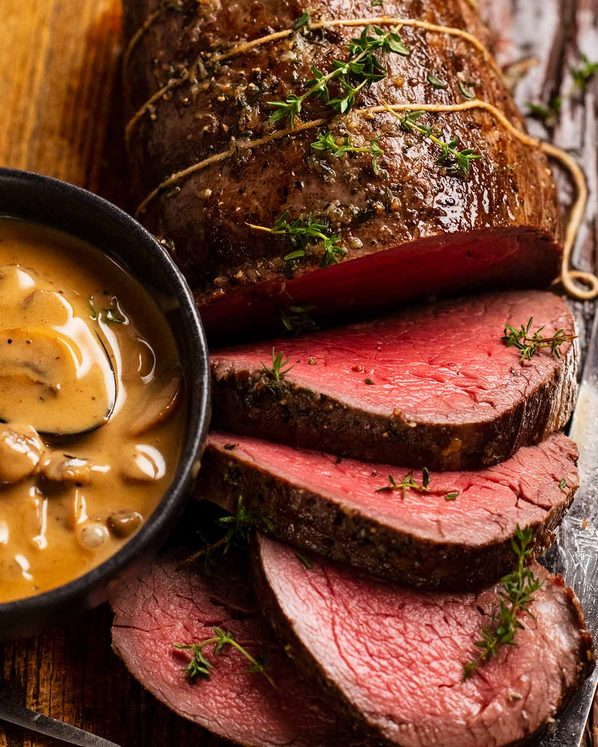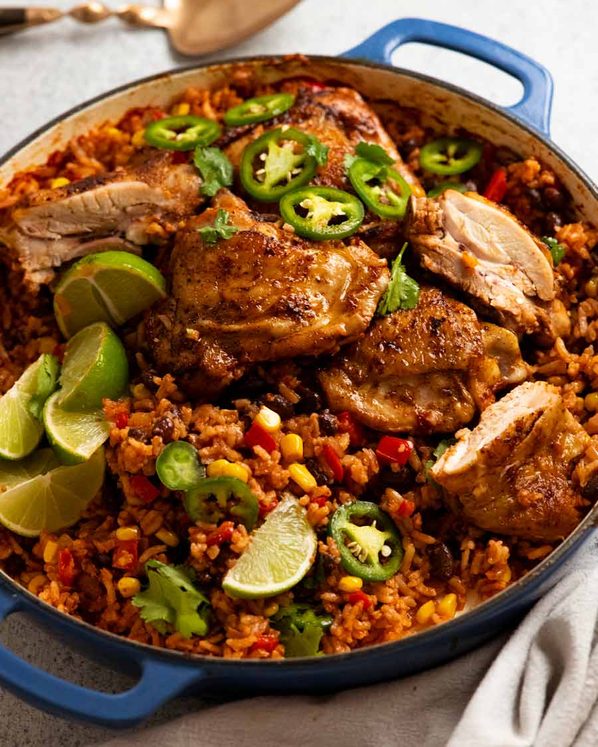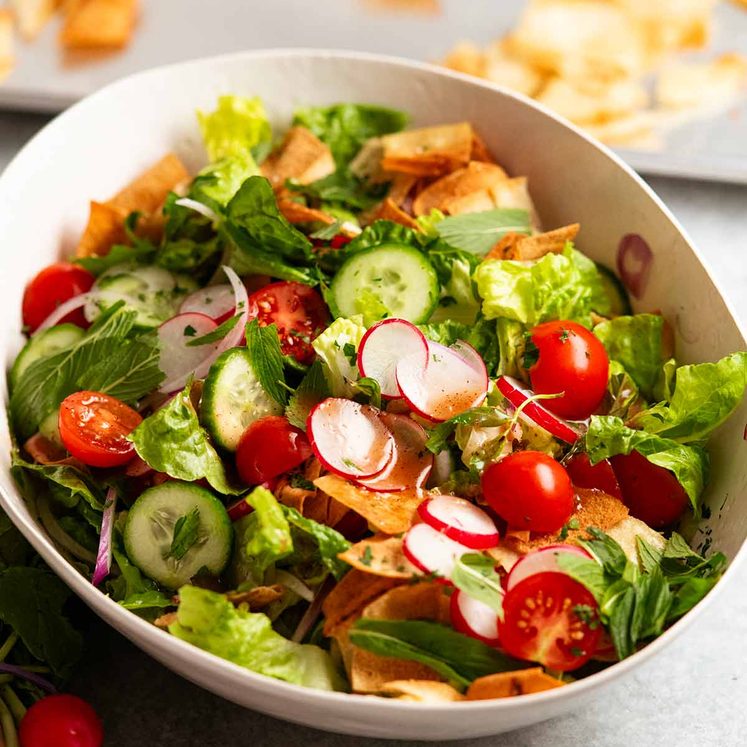This years’ brand new Christmas main has landed! You’ll love the simple but highly effective cooking technique used in this Roast Beef Tenderloin recipe for blushing pink meat from edge to edge. Slathered in garlic-thyme-butter and served with a dreamy mushroom sauce, to say it is delectable is an understatement. I hope you love it!
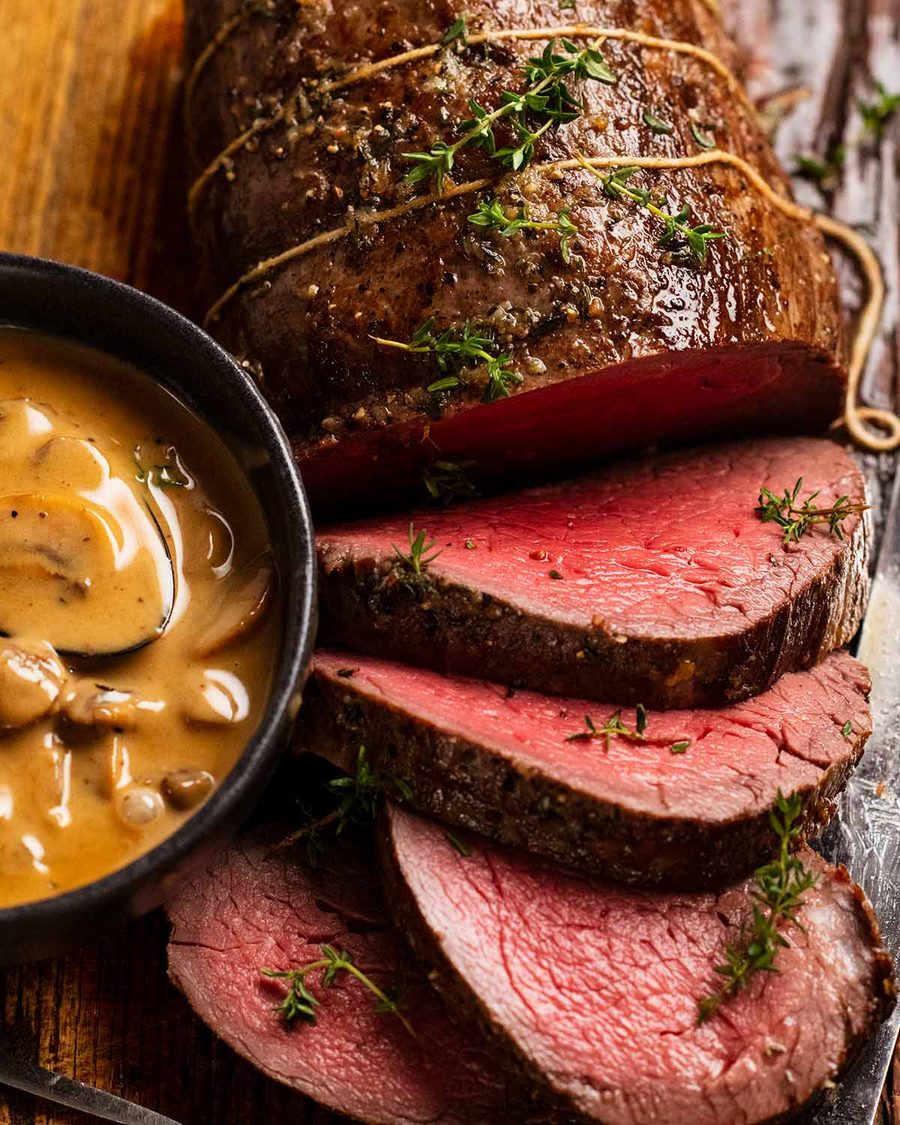
A beef tenderloin recipe – worthy and safe!
Beef tenderloin, also known as eye fillet, is one of the most expensive cuts of beef. It’s loved for how tender it is and because of the price, typically reserved for special occasions. So I really do not want to stuff it up, and I want to cook it in a way that is worthy of such a luxurious cut of meat!
So this method I’m sharing today is low risk, but yields exceptional results. It’s a proven method I also use for standing rib roast (prime rib), which has been a reader favourite for special occasions for years.
Here’s what you need to know about this recipe:
-
Method – Seared to brown the surface, slathered with garlic-thyme-butter then roasted in a low 120°C/250°F oven for 40 minutes.
-
The low temperature means the beef cooks evenly from edge to edge. At the typical 180°C/350°F, you get a thicker band of grey, overcooked meat. I can live with that for lamb leg, being a much larger piece of meat. Not for tenderloin – it’s smaller, which means the ratio of overcooked meat is higher!

-
Safer – Using a lower temperature also makes this recipe safer because it won’t go from perfect-to-overcooked in a minute like it does at higher temps.
-
Overnight salting – A recommended step for the absolute best results: Sprinkle beef with salt the night before and leave overnight in the fridge, uncovered. This will season the meat all the way through into the middle.

-
Premium v economy beef – While I typically only make beef tenderloin for special occasions and so I splurge on good beef, I also tried economical tenderloin and was so impressed with the results. However, you need to trim and tie it yourself. In doing so, you can save ~70%. See the Economical Beef section below.
-
Creamy mushroom sauce – A special creamy mushroom sauce, an elevated version of the everyday mushroom sauce I use midweek, made using every drop of the precious pan drippings. There’s little drippings from tenderloin compared to other beef, so choosing the right sauce is important. More on the sauce below.

About The Creamy Mushroom Sauce
One of the reasons it’s taken me years to publish a beef tenderloin recipe was the sauce conundrum. Beef tenderloin needs a sauce that is worthy (this is an expensive meat!). If I had my way, I’d ask you to make homemade beef stock so we can serve this with a red wine sauce because it’s so luxurious (recipe on page 327 of Dinner). But many readers wouldn’t, and you can’t make red wine sauce using carton stock (doesn’t have the gelatine so never thickens and it’s far too salty).
As for gravy? Unlike larger roasts, tenderloin doesn’t create enough pan drippings to make a good gravy. It’s too lean and too small.
So instead, I’ve chosen what I think is the best sauce for tenderloin – a mushroom sauce that’s made using every drop of flavour left in the pan from roasting. This sauce is Dreamy – with a capital D. 100% worthy of tenderloin!
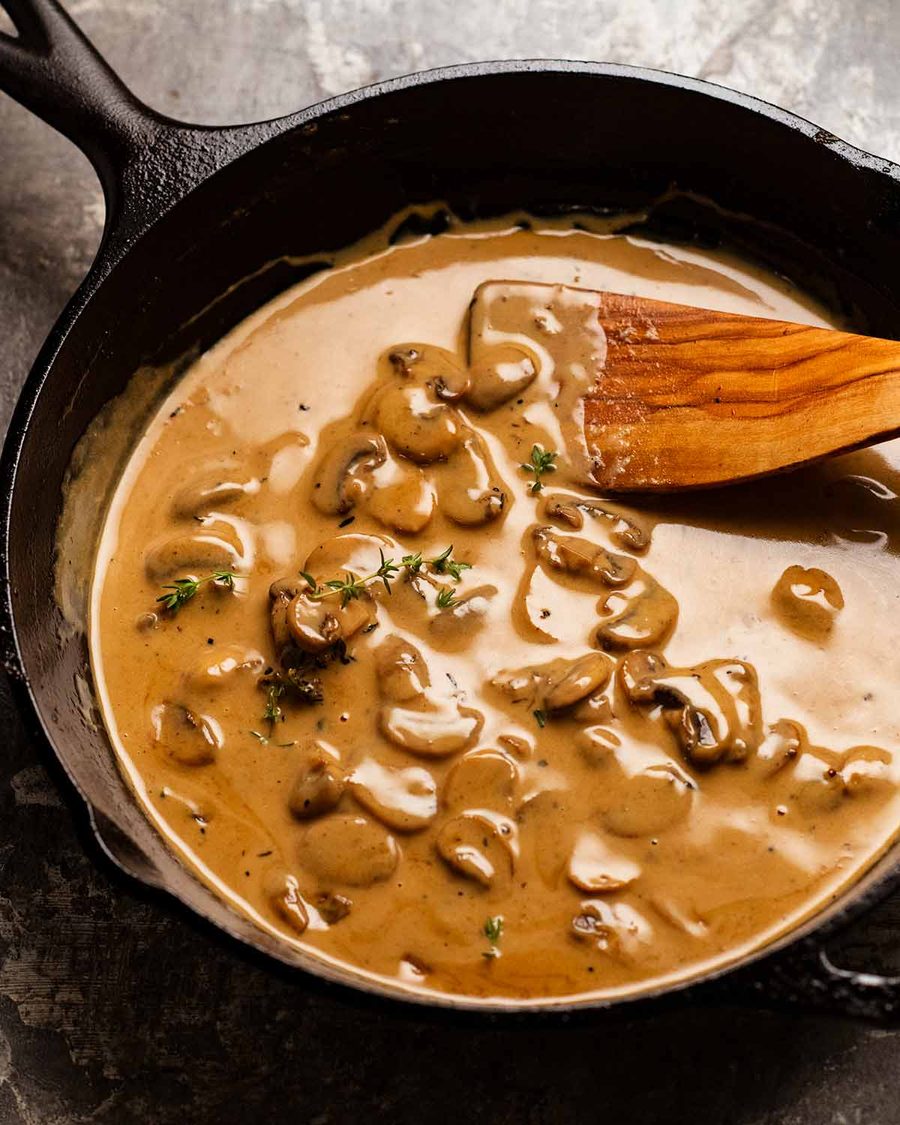
Ingredients
Here’s what you need to make this roast beef tenderloin.
1. Centre-cut beef tenderloin (eye-fillet)
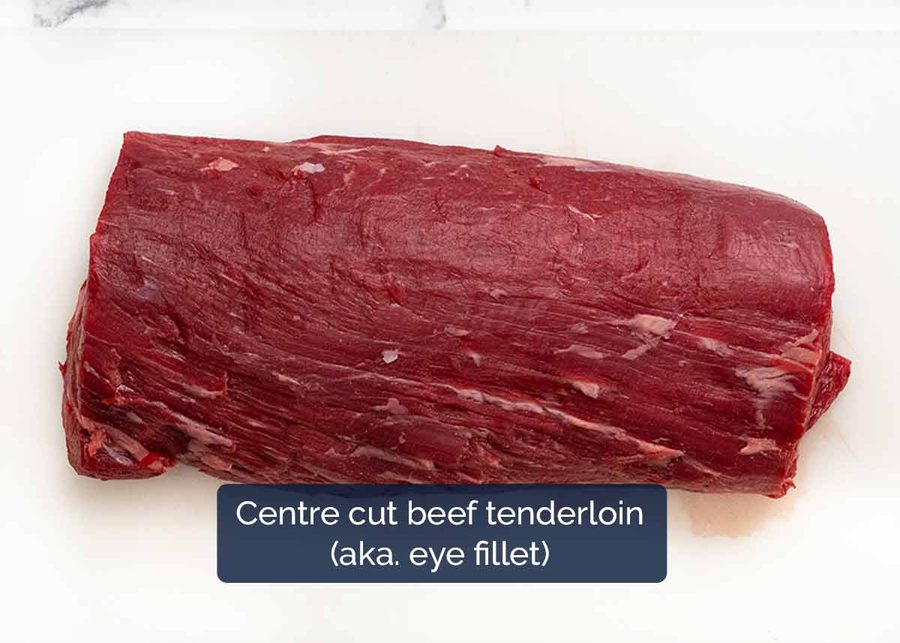
Beef tenderloin, also known as eye-fillet, is one of the most expensive cuts of beef that is prized for its tenderness. The best part of the beef tenderloin for roasting is the centre cut because it’s cut from the thick end of a long piece of meat that tapers like a tai, and it’s a relatively uniform shape so it roasts evenly.
It usually weighs between 1 – 1.25kg (2 – 2.5 lb) and if you pick one up from a quality butcher, it should be neatly trimmed and tied, as pictured (once I slathered in butter!).
The cost will range depending on the quality of the beef, but is typically around $40/kg from grocery stores up to $90/kg at good butchers ($20/lb – $45/lb).
Economical BEEF options
Beef tenderloin is cheaper if you get smaller roasts (~400-500g/14 – 17oz) which come from small beef tenderloins (lacks the impact of a big beef roast), if you get the tail end of beef tenderloin which tapers to a thin point, or if you have a whole tenderloin that you cut, trim and tie yourself (you can save 60-70%).
The whole tenderloin below was $30/kg from Harris Farms (currently discounted to $20/kg!), compared to $90/kg for the centre cut tenderloin pictured above (though note beef quality comes into play here too, see box below).
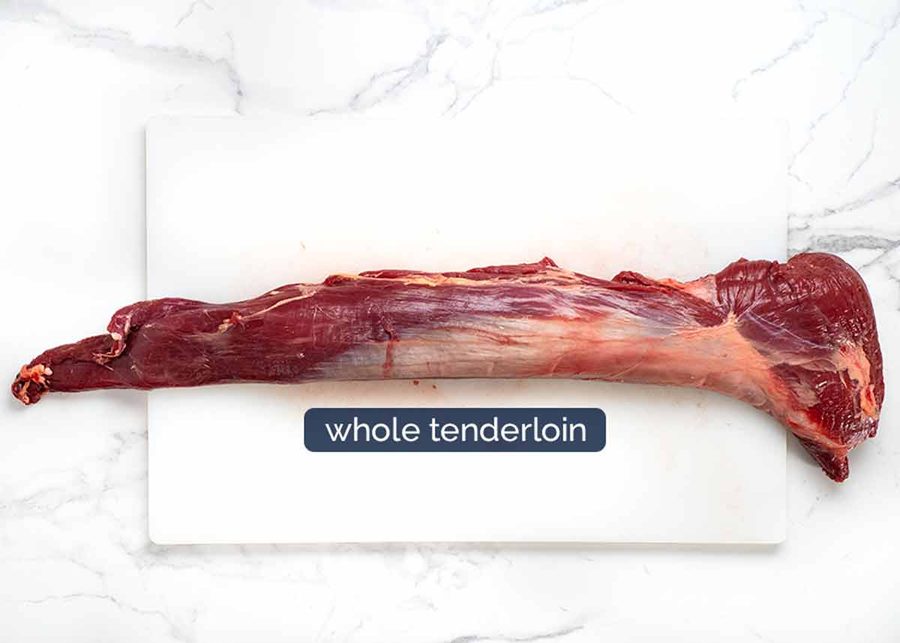
I’ve done a separate post on how to trim, cut and tie a whole tenderloin to make your own centre cut for roasting – see How to Trim and Cut Beef Tenderloin for Roasting.
Beef quality – why pay more?
A really good quality beef tenderloin will literally melt in your mouth, and you will barely need a knife to cut into it. Here are some of my pointers on beef quality!
-
Cheap v expensive beef – affected by breed, how it’s raised, what it’s fed, how it is processed and how the meat is stored. Certain heritage breeds are regarded as more desirable. How cows are fed also affects quality – grain or grass. Meanwhile, beef sweating in vac packs for weeks/months are cheaper, but quality suffers compared to freshly butchered carcasses.
-
Quality of life of the animal comes into play too – Animals that lived a good life will produce better-tasting meat (think battery chickens vs free range).
-
Grass v grain fed beef – Neither is inherently superior (flavour and texture wise) and it’s a matter of taste! Grain fed animals are bigger, the meat is more marbled with a richer, buttery taste. Grass fed cows are usually smaller, and the beef is less marbled and fatty. However it has a more complex and natural beef flavour that many enjoy. People often also prefer the idea of quality pastured beef raised naturally over cows fed on only grain in industrial feedlots.
-
Most Australian beef is in fact grass-fed, but note that many grass-fed animals are still finished on grain or eat some grain during their life. This is normal industry practice. If you want pure grass-fed beef, you need to specifically ask 🙂
Garlic-thyme-butter slather
This is what we slather onto the surface of the beef before roasting. By using softened butter rather than just pouring over melted butter you get a good amount of garlic sticking to the surface of the beef which is just all sorts of good!
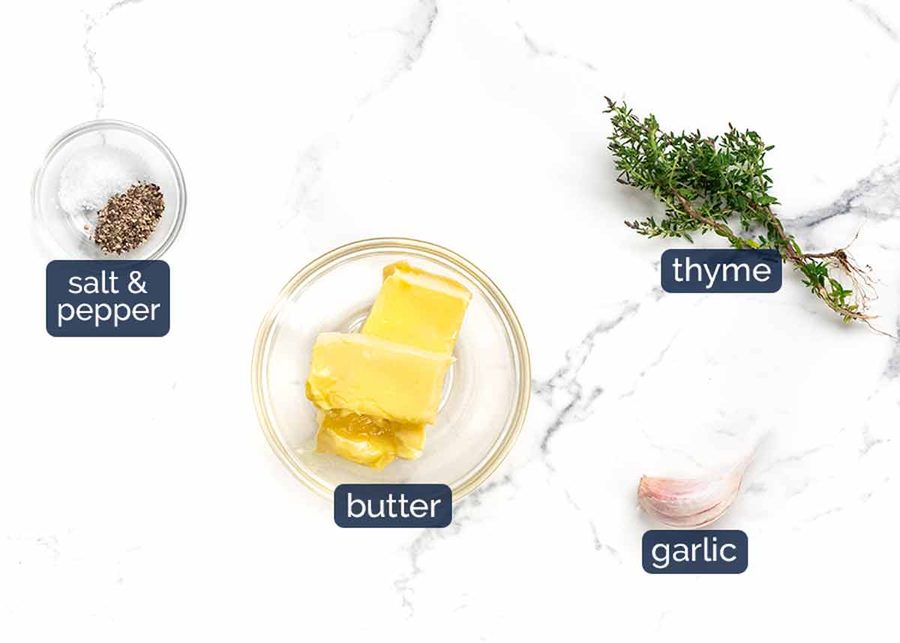
Thyme – If you don’t have fresh thyme, substitute with 1/2 tsp dried thyme crushed in your fingers to make it a powder.
Creamy Mushroom Sauce for Roast Beef Tenderloin
Here’s what you need for the creamy mushroom sauce which is heavenly with the beef! The magic ingredient is Marsala, an Italian fortified wine that gives the sauce a gourmet flavour. You need something for beef tenderloin – because it doesn’t produce enough drippings to make a good gravy like you can do with lamb leg, or red wine sauce like I make for beef prime rib (standing rib roast) without using a homemade beef stock (carton stock just doesn’t cut it). I really tried, but it just lacked flavour!

-
Marsala – As mentioned above, this is the ingredient that gives this sauce a gourmet edge. It’s an Italian fortified wine that you can pick up cheaply (I usually get Boronia Marsala $10 for a 750ml bottle though pictured below is a different brand), keeps “forever” and you need it to make the midweek beauty Chicken Marsala!
Don’t have it? Use white wine instead. It doesn’t have the earthy flavour marsala has but it’s nevertheless still going to be a delicious sauce!
For a non-alcoholic version, the best substitute is low sodium chicken stock.
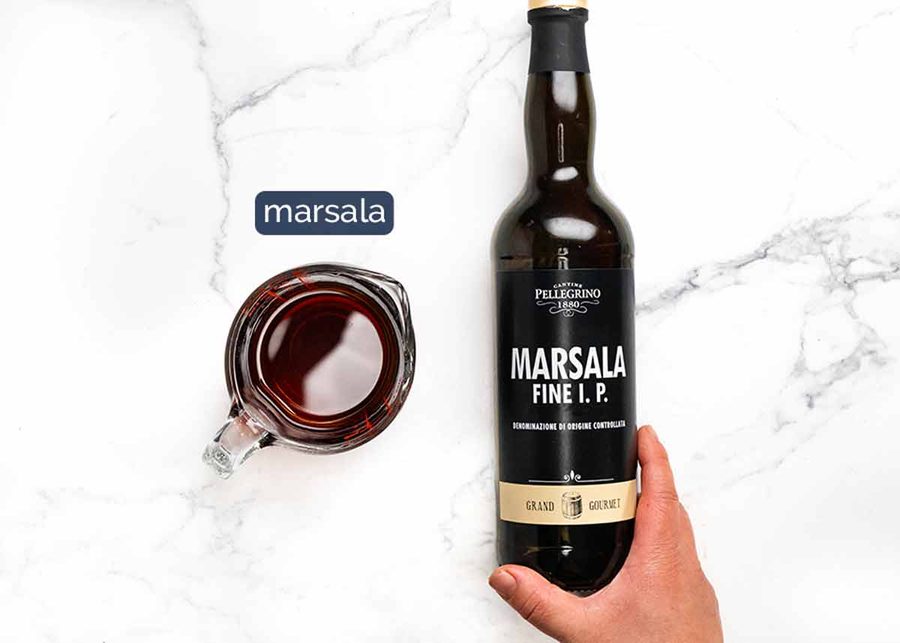
-
Mushrooms – I use white mushrooms because I like the colour in the sauce, but you can use Swiss Brown / Cremini mushrooms if you prefer.
-
Garlic – Not too much actually, just 1/2 a teaspoon. We don’t want to overwhelm the whole dish with garlic flavour and there’s already quite a lot in the butter slather!
-
Chicken stock/broth – Because it’s better than water.
-
Cream – Because we’re making a creamy sauce. Use thickened / heavy cream because it’s thicker than ordinary cream.
-
Thyme sprig – For a perfume of thyme flavour in the sauce without ending up with loads of little black specks in the sauce. Though, you can substitute with dried thyme if you have to. But, be warned – black specks!!
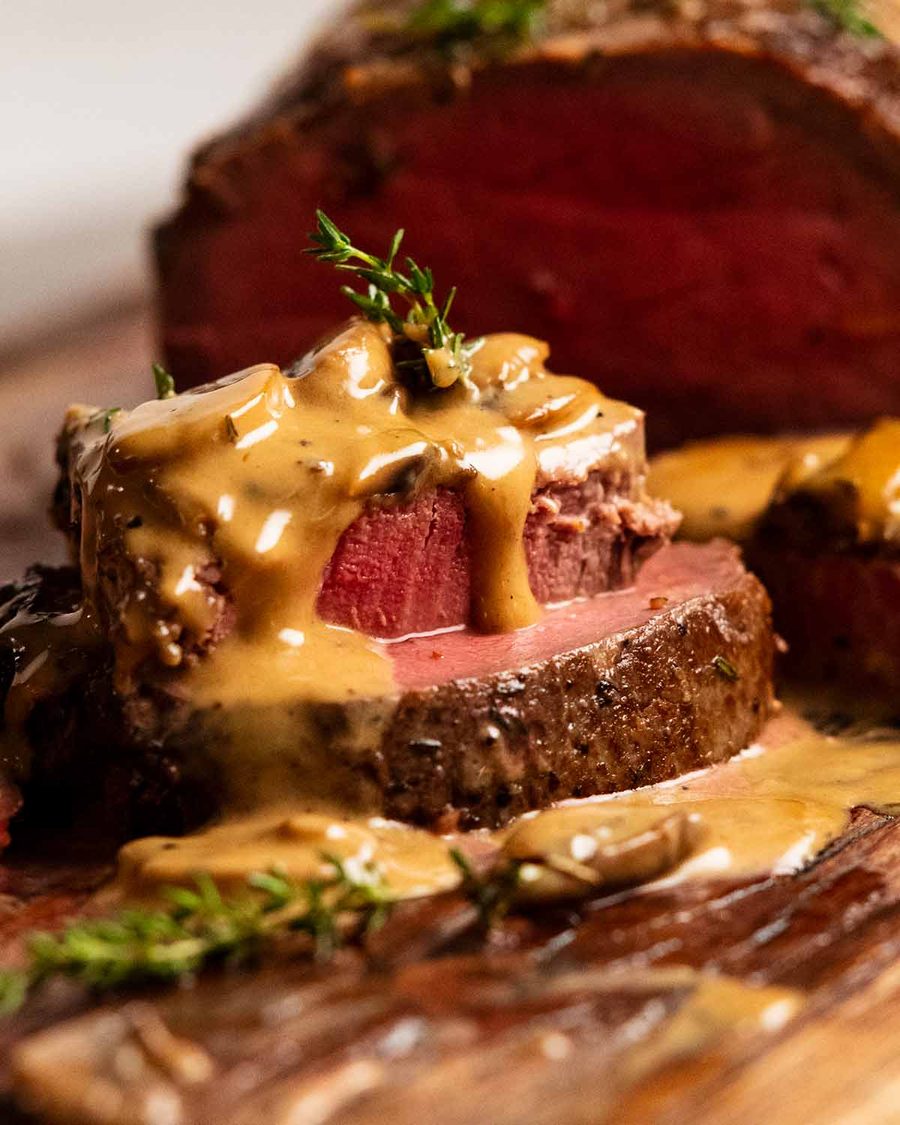
Internal cooked temperature of beef tenderloin
Medium rare is the recommended level of doneness for beef for the most juicy results, and the default doneness for restaurants. Target an internal temperature of 53°C / 127.4°F when taking it out of the oven which will rise to 56-58°C / 133-136.4°F after resting for perfect medium rare.
However, you should cook your beef to the doneness you like! Use the table below.
| Doneness | Pull Temp out of oven |
Target Temp after rest |
|---|---|---|
| Rare | 50°C/122°F | 53°C/127.4°F |
| Medium rare (recommended) | 53°C / 127.4°F | 56-58°C / 133-136°F |
| Medium | 56°C/133°F | 60°C / 140°F |
| Medium well | 60°C / 140°F | 65°C / 149°F |
| Well done | Never! | n/a |
How to make Roast Beef Tenderloin
Roasting in a low 120°C/250°F oven is the key here which actually doesn’t take that long (just 40 minutes). This yields exceptional results with evenly cooked beef from edge to edge (no thick overcooked band you get from higher temps) makes this recipe shockingly straightforward and virtually risk-free. Because you’ve got a meat thermometer, right? 🙂 Even a cheap $5 one from Kmart is better than winging it with a premium cut of beef like tenderloin!
** START THIS RECIPE THE NIGHT BEFORE by salting the beef. This does wonders to get seasoning into the flesh and to dry out the surface for a superior crust.
1. low-temp-roasting

-
Tied beef – If your beef is not tied, tie it with kitchen twine at 2.5cm / 1″ intervals. This will hold your beef together in a nice shape as it roasts. However, it’s not the end of the world if you don’t tie it! Your beef will just sort of sag a bit.
Caveat – If you’re using an economical piece of tenderloin with flappy bits and the thin tail, tying is essential. See section above about preparing economical tenderloin.
-
Overnight salting (not deal breaker) – Pat the beef dry with paper towels, then sprinkle with salt and pepper all over. Place the beef on a rack on a tray then refrigerate uncovered overnight.
Why salt overnight?
This is essentially dry brining where the salt penetrates all the way through the flesh so it’s seasoned in the middle which makes the beef tastier to eat. The other benefits are that the surface will dry out so it sears beautifully, and I find that salted meats cook faster. I salt my steaks these days too and they cook ~30% faster. Tenderloin cooks about 5 – 8 minutes faster.
Can’t do it? That’s ok! While this step is recommended for the best results, it is not the end of the world if you don’t have time to do this because we have our lovely sauce! Just salt then cook immediately.
BUT! If you don’t have time for overnight salting, don’t salt and let it sit around for a few hours, the surface gets wet = takes longer to sear = thicker overcooked band. Either salt and leave for 12 hours+, or salt and cook straight away.

-
De- chill – Remove beef from the fridge 2 hours prior to remove some of the chill from the centre. This helps the beef cook more evenly by taking some of the chill out of the centre of the beef.
-
Butter Slather – Mix Butter Slather ingredients in a bowl.

-
Sear fast! Sear the surface of the beef all over in an ovenproof heavy based skillet on high heat (I use my 26cm / 10.2″ Lodge cast iron skillet). We want to do this step hard and fast, to minimise time on the stove so we minimise the thickness of the band of meat that becomes well done by then end of the roasting time!
-
Cool briefly – Then put the beef back on the rack to cool for 15 minutes. The purpose of this is so the butter doesn’t completely melt when you slather it on.

-
Slather 3/4 of the butter onto the beef – top and sides (not underside). Using softened rather than melted butter does wonders to make the garlic stick to the surface of the beef!
-
Slow roast 40 to 50 minutes – Transfer the beef into the skillet then roast for 15 minutes in a low 120°C/250°F oven (both fan and standard ovens). Then slather the remaining butter on and roast for a further 25 – 35 minutes (40 – 50 minutes total) or until the internal temperature is 53°C/127°F for medium rare. (See table in box above for other levels of doneness).
Note: Typically, fan ovens are 20°C lower than standard for the same cooking speed. But at lower temperatures I find this not to be the case. Discovered this during 12 hour lamb testing!

-
Rest – Remove beef from the skillet and rest for 10 minutes. The internal temperature will rise to 56-58°C / 133-136°F which is medium rare.
Note for roasting pros: It rises less than larger roasts (like a standing rib roast /prime rib which takes 1 1/2 hours in the oven) because it is not in the oven as long so the residual heat in the meat is less.
-
Slice thickly and serve with Creamy Mushroom Sauce!
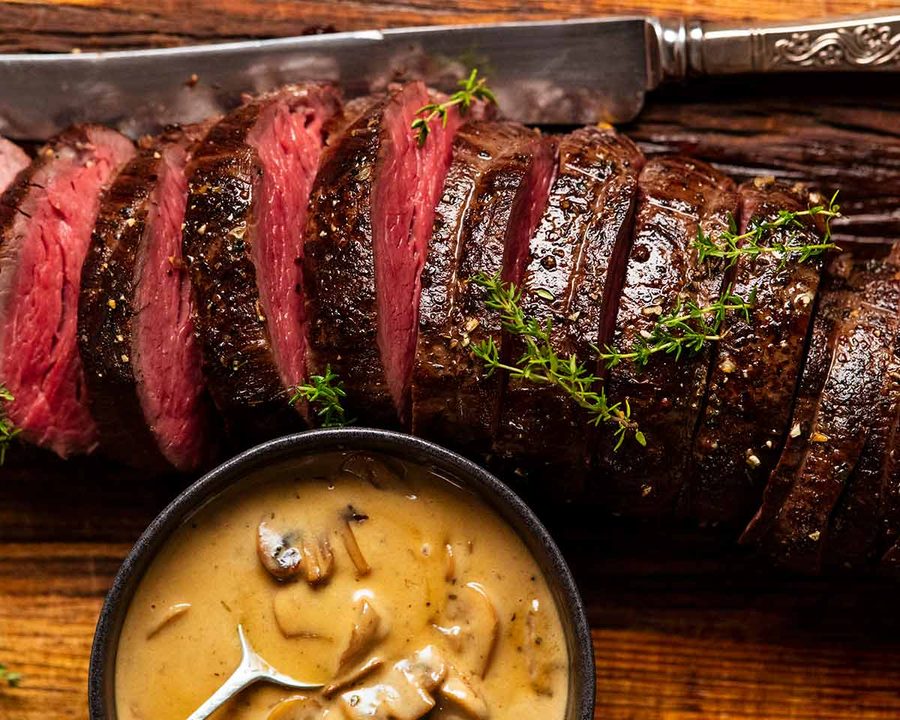
HOW TO MAKE The mushroom sauce
As noted earlier, beef tenderloin does not create as much pan drippings as larger roasts with more fat. So we’re going to add a couple of extra steps and ingredients to make a beautiful sauce worthy of tenderloin without wasting a drop of flavour in the skillet!
What I do is use the butter / little amount of beef fat in the skillet to sauté the mushrooms, then all the meat juices as part of the stock for the sauce. The result? A dreamy mushroom sauce that’s worthy of any high-end steakhouse!

-
Roasting juices – Pour all the juices in skillet into a bowl, scraping out all the little bits of garlic.
-
Spoon off butter – Spoon or pour off 1/4 cup of the fat that rises to the top of the juices and pour it back into the skillet. Keep the rest of the juices/fat – we will add it into the sauce later.

-
Cook mushrooms – Turn the stove onto high. Once the butter is hot, add mushrooms and cook until they start to sweat. Then add thyme and garlic, and cook for a further 2 minutes until the mushrooms are softened.
-
Sauce – Add the chicken stock/broth and reduce by half. Then add the marsala, reduce by about half – this will cook out most of the alcohol. Then add the cream, pepper and all the remaining reserved roasting juices, including all the garlic bits (there’s lots of salt and flavour stuck in there).

-
Simmer on medium / medium high for 5 minutes until it reduces by half and the sauce is thickened to a thin syrupy consistency (it will thicken more as it cools in the time it takes to get from the pan to your plate). Taste – it should be slightly on the salty side (which will seem just right with each mouthful of beef). Add more salt if needed.
-
Transfer into a bowl with a spoon to serve with the beef!

What to serve with beef tenderloin
I actually shared the Brie Dauphinoise Potatoes on Monday with the intention of suggesting to serve it alongside this beef tenderloin. It’s worthy! Though, so is traditional no-brie Dauphinoise. 🙂
Also, from a practical perspective, it’s easy to time it. Make the Brie Dauphinoise first. Then cover to keep warm while you cook the beef. It’s a solid mass, it will stay warm while you’re roasting the beef.
While the beef is resting, pop the dauphinoise back in the oven to give it a 10 minute blast in the oven to re-warm the surface. Then voilà! Serve both hot and fresh. 🙂
More side suggestions
Few more classic roast beef side suggestions for you: Creamy Buttery Mashed Potato, Sautéed Green Beans with Garlic, Garlic Sautéed Spinach, Lemon Potato Salad. Or, have a browse of my vegetable sides recipe collection (it’s even sorted by vegetable), and more potato sides here. – Nagi x
PS Short note on leftovers: serve cold, thinly sliced, on rye with a smear of mustard, for the best roast beef sandwich you’ll make all year.
Watch how to make it
Hungry for more? Subscribe to my newsletter and follow along on Facebook, Pinterest and Instagram for all of the latest updates.
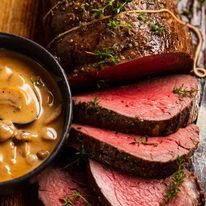
Beef Tenderloin with Creamy Mushroom Sauce
#wprm-recipe-rating-0 .wprm-rating-star.wprm-rating-star-full svg * { fill: #343434; }#wprm-recipe-rating-0 .wprm-rating-star.wprm-rating-star-33 svg * { fill: url(#wprm-recipe-rating-0-33); }#wprm-recipe-rating-0 .wprm-rating-star.wprm-rating-star-50 svg * { fill: url(#wprm-recipe-rating-0-50); }#wprm-recipe-rating-0 .wprm-rating-star.wprm-rating-star-66 svg * { fill: url(#wprm-recipe-rating-0-66); }linearGradient#wprm-recipe-rating-0-33 stop { stop-color: #343434; }linearGradient#wprm-recipe-rating-0-50 stop { stop-color: #343434; }linearGradient#wprm-recipe-rating-0-66 stop { stop-color: #343434; }
Ingredients
Beef:
- 1 – 1.25kg/ 2 – 2.5lbcentre cut beef tenderloin(eye fillet), tied (Note 1)
- 1 1/2tspcooking / kosher salt
- 1/2tspblack pepper
- 1tbspvegetable oil
Garlic-Thyme-Butter-Slather:
- 75g/ 5 tbspunsalted butter, softened
- 1tspgarlic, finely grated or very finely minced with a knife
- 1tspfresh thyme leaves, finely chopped (Note 2)
- 1/4tspcooking/kosher salt
- 1/4tspblack pepper
Creamy mushroom sauce:
- 150g/5 ozwhite mushrooms, sliced 3mm thick
- 1/2tspgarlic, finely minced
- 1thyme sprig(Note 2)
- 3/4cupmarsala, Italian fortified wine (Note 3)
- 1/2cupchicken stock, low sodium
- 3/4cupthickened cream(heavy cream)
- 1/4tspblack pepper
Instructions
-
Prep beef – Pat beef dry with paper towels, sprinkle with salt and pepper all over. Place the beef on a rack on a tray then refrigerate uncovered 12 to 24 hours. (Can skip, Note 5)
-
Butter Slather – Mix Butter Slather ingredients in a bowl.
-
De-chill – Remove the beef from the fridge 2 hours prior to cooking. This helps the beef cook evenly.
-
Sear – Heat oil in an ovenproof heavy based pan over high heat until smoking. (Note 6) Brown the surface of the beef all over, aggressively and quickly. Then put the beef back on the rack to cool for 15 minutes (so the butter doesn’t instantly melt when you put it on).
-
Preheat oven to 120°C/250°F (both fan and standard ovens) (Note 7).
-
Butter – Put beef back in cooled skillet. Slather 3/4 of the butter onto the beef – top and sides (not underside).
-
Roast 40 – 50 minutes – Roast for 15 minutes. Remove, slather remaining butter onto the top and sides. Roast for a further 25 – 35 minutes or until the internal temperature is 53°C/127°F for medium rare (Note 8 for other levels of doneness).
-
Rest & serve – Remove beef from the skillet onto a cutting board and rest for 10 minutes. The internal temperature will rise 56-58°C / 133-136°F (this is medium rare). Slice thickly and serve with Creamy Mushroom Sauce!
Creamy mushroom sauce
-
Roasting juices – Pour all juices in skillet into a bowl or jug. The fat will rise to the surface. Pour off 1/4 cup (60ml) of the fat back into the skillet (reserve the rest for later).
-
Cook mushrooms – Turn the stove onto high. Once the butter is hot, add mushrooms and cook until they start to sweat. Then add thyme and garlic, and cook for a further 2 minutes until the mushrooms are softened.
-
Sauce – Add chicken stock/broth and reduce by half. Add marsala, cream, pepper and remaining reserved roasting juices. Simmer on medium / medium high for 5 minutes until it reduces by half and the sauce is thickened. Taste – it should be slightly on the salty side (which will seem just right with each mouthful of beef). Add more salt if needed. Serve with beef.
Recipe Notes:
| Doneness | Pull Temp out of oven |
Target Temp after rest |
|---|---|---|
| Rare | 50°C/122°F | 53°C/127.4°F |
| Medium rare (recommended) | 53°C / 127.4°F | 56-58°C / 133-136°F |
| Medium | 56°C/133°F | 60°C / 140°F |
| Medium well | 60°C / 140°F | 65°C / 149°F |
| Well done | Never! |
9. Leftovers will keep for 3 days. Freezing not recommended.Nutrition per serving, assuming all sauce is consumed.
Nutrition Information:
Life of Dozer
The smell of roasting beef…..
